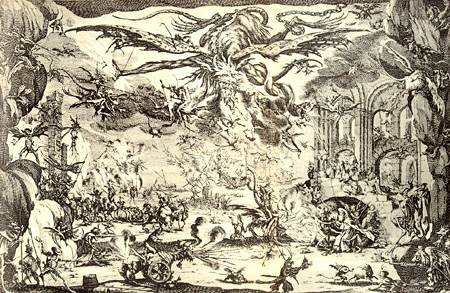ART: Every day was Halloween for medieval monster makers
Posted on October 29, 2012 By Stuart Adams Culture, Features, Visual Arts
Zombies want your brains and vampires want your blood, but the modern pop monsters have nothing on the creepy creatures lurking in the Art Gallery of Alberta – they want your souls.
The macabre exhibition “Beautiful Monster: Beasts and Fantastic Creatures in Early European Prints” opened just in time for Halloween and is up until March with 50 woodcuts, etchings and engravings created in 15th, 16th and 17th Centuries, at a time when Europe had just emerged from the Dark Ages.
The works are displayed in five sections: religious “chimeras” (imaginary monsters whose body is a grotesque combination of mismatched animal parts), mythological creatures, sea monsters, war horses and decorative motifs. And while the subjects offer titillating Halloween images for a 21st Century audience steeped in grotesque aliens from outer space, the exhibition is noteworthy on a number of levels.
First, the fascination with monsters can be traced to the Latin “monstro,” which is the verb “to show”, and which the exhibition text indicates that “points to the early understanding of monsters as a signs or portents that disrupt the natural order.” These images come from a time when evil walked the earth, when death was not far away. The average life expectancy of those who survived infancy was the early ‘30s. The Black Death had decimated the population and would continue to do so, on and off, for 150 years.
Gothic churches were decorated by gargoyles, which represented evil, “meant to compel people to enter the church by reminding them that the end of days was near, and to ward off evil so as to keep churchgoers safe.” And while few people could read, the new printmaking technology was making these images available to wider audiences – not unlike the Internet is doing today.
For sheer artistic ability, the works are incredible. The collection, organized and drawn from the National Gallery of Canada, prominently presents 10 pieces by Albrecht Durer, a renowned master from the late 1400s and early 1500s. His images demonstrate an exactness and detail verging on a photorealistic effect – even though they were created with relatively primitive equipment and materials. What would Durer have thought about his prints being purchased 600 years later for up to $20,000?
Other noteworthy artists are Andrea Mantegna and Jacques Callot. Mantegna’s Battle of the Sea Gods (Left Side), circa 1485-88, emulates an additional interest in mythological characters. A serpent-tailed horse and clawed-footed chimera indicate only a fragment of the artist’s imagination.
Similarly, Callot’s The Temptation of Saint Anthony (Second Version) from 1635 (below) demonstrates a rich sense of the macabre and a seeming fascination with things anal.
Not all the images are entirely provocative. A few are tiny – about the size of the footprint of a computer mouse. But they combine for a fascinating window on a past that was far different from today, but which demonstrates that some things remain the same.













